How To Start Learning Music Theory
Music theory is frequently maligned, misunderstood, or downright feared amidst musicians and non-musicians alike. All the same, exploring theory tin serve to enrich your enjoyment of music, help fuel your creative procedure and unlock some very mysterious doors, leading to an heady and endless creative spark.
This article is for anyone with even the slightest interest or marvel about learning music theory, and it'due south designed to encourage you to explore your creativity through learning music theory. Don't be afraid to read through until the end; information technology's worth information technology.
If you're start your journey, you volition not grasp 100% of all of this, and that's the point. Basic theory can create more questions than answers, and a complete primer like this will brainstorm introducing concepts and musical vocabulary that volition testify upward big time downward the line. Keep reading and absorbing, and at some signal, information technology's all going to "click".
What is music theory?
Just put, music theory is the linguistic communication with which we communicate musical ideas. It allows u.s.a. to put our ideas into words, communicate those ideas with other musicians, and organize our thoughts, feelings, and propositions into a language that we all every bit musicians can empathize. It'south a language that transcends national boundaries, cultures, religions, political views et al., and when you look at it that fashion, one of the greatest achievements of humankind.
Music theory is a universal language, one that continues to evolve over thousands of years. It'due south part science, part math, and part art. In this commodity, we're going to dive into the depths of beginner music theory; what it is, how information technology works, and how you lot can make information technology work for you.
Why should you learn music theory?
One of the biggest myths about creativity, as it pertains to music, is that learning music theory somehow could make you a less artistic artist. This myth is a logical fallacy and just downright untrue. A greater control and deeper agreement of music theory adds more tools to your kit and ameliorate equips y'all for various musical and compositional situations.
You may hear statements or read comments online about how legendary musicians like Kurt Cobain or Jimi Hendrix didn't know theory and how it didn't affair, but this besides is partially untrue and irrelevant.
You lot see, Kurt, Jimi, and every other musician take at least some understanding of the fundamentals of their instrument and creative process, even if they speak a slightly unlike language. My point here is that while Hendrix may non have known specific musical terminology or root rote fundamentals, he withal had his own arrangement and conceptual framework to fulfill his creative expression. He had a sufficient enough understanding of his craft to communicate his artistic ideas effectively. Having more options at your disposal will never make you less creative, so never rule out learning theory based on this fear.
It's of import to notation that while theory can be the cause and art or music the effect, theory is a language that nosotros use to communicate our ideas and to solve creative problems as they arise. This means that inspiration and expression will always take priority over post-obit "rules". Nonetheless, having the theoretical noesis to plug gaps in your creative process is indispensable and a must for any musician that aspires to dandy artistic achievement.
This is besides an essential takeaway earlier we dive in: yous don't need to use all of the theory y'all know all the fourth dimension. This is an express train to impale the creative process and sound like an encyclopedia. Call up, theory is there to communicate effectively and to solve issues as they arise. Don't invent problems for yourself to solve so that y'all can flex your skills. That's what ToneGym is for... Follow your curiosity, invention, and spark, and allow theory exist the foundation that helps to support the fantastic skyscraper yous're fabricating.
How to larn music theory? - Traditional vs. Mod methods of learning
Traditional methods of learning music theory typically involve in-person training and instruction, either at school or with a individual teacher. The Traditional Method has students learning to play an instrument early in life and learning to sight-read music simultaneously. Other methods are used besides, such as the Orff method, which uses a multi-directional approach involving movement, speech, and improvising. The Kodály method believes that singing is the foundation of musical learning and teaches students using solfeggio and mitt movements to sight-sing music.
From Baby Boomer to Millennials, many generations will have grown upwardly learning theory from Walter Piston'southward heavy three-volume tome: Harmony, Counterpoint, and Orchestration. This is combined with rigorous exercise in figured bass, vocalisation leading, and limerick, often without learning a musical instrument. In that location are also the university methods, such equally the Berklee method, which was developed by Lawrence Berk and oft bucks against traditional guidelines of voice leading and harmony. These methods are all-time learned while attending said university and preparation under its professors.
With music programs becoming less and less prevalent at public schools, many students (and adults) may lack access to quality music teaching in the traditional manner. In add-on, private lessons or studying at an expensive solarium can be cost-prohibitive.
Enter the world wide web and its many gifts to democratize learning. Music pedagogy is now more than accessible than ever, albeit a bit oversaturated. Modern methods include sites like ToneGym, paid subscriptions, YouTube videos, online lessons (grouping and individual), and smartphone apps. With so many methods of learning theory to cull from today, knowing where to start can be an honest struggle.
Yous should explore and observe a method you lot similar, such as the lessons available in the ToneGym School, and stick with it for a while. Pulling from too many sources early tin make learning any new skill more challenging and confusing than necessary. While at that place are plenty of paths to follow, some may disharmonize with one another. While a more expert theoretician or artistic person may be able to have what they like and go out the remainder, it's essential to have consistency and structure early in your learning process.
That being said, if something isn't working for you lot, don't exist afraid to driblet it and notice something else that gets meliorate with your method of learning.
The basics of music theory
Music is made up of three fundamental parts; Tune, Harmony, and Rhythm.
Melody is a sequence of single musical notes arranged to please (or upset) the listener. Depending on their structure, melodies can feel happy, distressing, aroused, foreboding, dark, brilliant, goofy, or triumphant. We use tune to convey musical feelings or to acquit a message using tongue (lyrics). We'll elaborate on this before long.
Harmony is the combination of different musical notes being sounded simultaneously. Harmony is used to enrich the melody, communicate our feelings more than elaborately, and create motility or motility within the piece. In Western music, harmony is typically plant in the form of chords (a group of three or more notes) and chord progressions (a series of chords played in sequence). These chord progressions have distinct sounds based on their arrangement, which set the tone of the music and the emotions conveyed to the listener.
Rhythm is the foundation for the message conveyed by a slice'south melody and harmony and expresses itself every bit a series of regular, repetitive sound patterns. Rhythm is how we proceed fourth dimension and create flow. Each element in a musical piece has rhythm, whether it'southward the timing of the notes that comprise a song'south tune or the design of the chords played as harmony within a song.
In contemporary music, rhythm is ofttimes synonymous with drums or drum beats. This can come in the form of an acoustic drum kit, programmed electronic drums or MIDI drums, or things like handclaps and percussion (maracas, shaker, bongos).
When all three of these elements are nowadays, we have music. Let's take a expect at a few examples and practice hearing this for ourselves.
Try listening to "Redbone" past Childish Gambino beginning and run into if you can find and identify melody, harmony, and rhythm throughout the piece on your own.
Right away, we can hear the drumbeat and bass guitar creating a steady pulse or rhythm that carries the vocal from the start. At the aforementioned time, a filtered guitar audio enters, playing a single note melody line. This melody is followed past another; Donald Glover'south vocals at 0:thirty. You can hear a soft, Wurlitzer-similar piano providing chordal accompaniment past moving through a simple chord progression (the harmony) throughout the slice.
This famous piece past Richard Wagner contains all 3 of the cadre elements of music, but in ways that may exist less easily identifiable to our modernistic ears. Let'south accept a listen…
What did you hear?
It may be obvious that Ride of the Valkyries is music, just why? There aren't whatever repetitive pulsate sounds or percussion to speak of or singing. Let'due south take a closer look. The pattern played by the soft horns at the very beginning of the piece creates a steady rhythm, interspersed with the falling and rising sound of the high strings, which also follow a repetitive, rhythmic pattern until 1:18. The melody is carried by the horns, with supporting harmony from the rest of the horn section and implied past the string parts' movement.
You lot'll discover that percussion is used in this slice merely as an accent (like at 2:08), not to bear or create the song's rhythm, which is quite different from modern music, where the drums and cymbals are used most oft to create a drumbeat or groove.
The rudiments of music theory
The music alphabet
But like learning a spoken linguistic communication, learning the musical alphabet is the first footstep in understanding the universal language of music. The musical alphabet uses characters from the standard English alphabet with a few additions such as # and ♭ (sometimes written using a lowercase letter "b").
Here is the alphabet get-go to finish:
C - C#/D♭ - D - D#/E♭ - E - F - F#/Thou♭ - G - Chiliad#/A♭ - A - A#/B♭ - B
Expect similar gibberish? No sweat, information technology's piece of cake. The musical alphabet comprises 12 notes labeled with the letters A through Grand, but begins with the letter "C". This is because the major musical key associated with "C" contains no sharp or flat notes, in other words, it contains all of the white keys on the pianoforte. Therefore, this is considered "abode base of operations" when we begin a discussion about music theory.

Sharps (#) and flats (♭) are notes betwixt notes. If we start on a white primal and motility upwardly to a blackness key, the annotation is sharp. If we start on a white primal and movement downwards to a black key, the note is flat. These are called accidentals.
You may find that some notes take two names! These notes sound exactly the same but tin can be labeled differently depending on context or the song's musical fundamental. The term for these notes is enharmonic. For example, you'll notice that the black key between "F" and "G" tin can be labeled every bit "F#" or "G♭". Yous'll want to memorize these names.
The notes "E" and "B" don't accept precipitous notes that follow them. This is considering the current Western arrangement of well-tempered tuning doesn't allow room for any additional notes (there are 12). Therefore, "E#" is just "F" and "B#" is "C". Consequently, "C♭" is but "B" and "F♭" is but "East". The merely time "Due east#", "F♭", B#" or "C♭" appear is equally a technicality when labeling some chords and scales.
Occasionally you may see a double flat (♭♭) or double abrupt (x) sign. While these are quite uncommon, they do appear in some contexts. Don't get hung up on this, as far as the basics go; y'all're pretty much covered with knowing the standard serial of sharps and flats.
Scales
A musical scale is a sequence of notes played in a specific order, co-ordinate to the formula for the scale. Chords, progressions, melodies, and harmonies all come up from scales, and then they're incredibly important to learn. The well-nigh important scale in Western music is the major scale (also chosen the Ionian mode). We use this scale as a signal of reference when discussing music theory and constructing other scales.
Near scales in Western music contain seven (vii) notes. A few notable exceptions include the pentatonic (five notes) and hexatonic (six notes) scales. These scales are borrowed from other musical systems, notably those of Asia and Sub-Saharan Africa...
Diatonic scales in western are synthetic from patterns of "whole" and "one-half" steps (too called whole tones and semitones). A whole step is 2 keys away on the piano (such as "D" to "E"), while a half pace is just i key away on the piano (such as "C" to "C#").
Here is the step formula for the standard "major" scale.
W W H Westward W W H
Applying this formula to the musical alphabet beginning on ANY notation will create the respective major scale beginning on that annotation.

C - C#/D♭ -D - D#/Eastward♭ -E - F - F#/G♭ - 1000 - Grand#/A♭ -A - A#/B♭ -B -C
W W H Westward W Due west H
We then refer to each note in the scale as a "caste". The first annotation is the "showtime" degree, the 2d annotation is the "2d" scale degree and and so on. The outset notation in the scale is usually as well called the "tonic".
From this numerical perspective, the major scale is "spelled" 1 2 3 4 5 6 seven. This is the almost mutual manner to refer to scales in theory, every bit this numbering could be applied to whatsoever scale in any key and produce the same result.
Each scale has vi boosted permutations called "modes". A manner is created when the calibration is played beginning and catastrophe on a different note in the scale, other than the tonic.
This rearranges the club of whole and half steps, thereby changing the sound and tonal quality of the mode.
For example, if nosotros begin the "C" major calibration on the 2d note, "D" and play the notes from start to stop, we get a new scale chosen the "Dorian" mode.
D East F G A B C D
Every bit you tin can come across, the Dorian fashion contains the same notes as the "C" major scale, only played in a different club. The order of whole and half steps is now: W H West West W H W. Because of this, the Dorian mode sounds very unlike from the "C" major calibration. Many concord that it has a darker, more than mysterious quality.
It's important to come across how we tin synthesize the Dorian mode from the standard major scale (walk from ane to another). If nosotros apply the numbering classification from to a higher place, we tin can see that the formula for producing the Dorian style from the major calibration is thus: 1 2 ♭iii 4 5 6 ♭7. The difference between major and Dorian is the lowered or flattened third and 7th scale degrees. Simply put, if we play the "C" major scale and lower the third and 7th notes by ane key or half pace, nosotros've congenital the Dorian mode beginning on the same note.
Here are the formulas for the rest of the "diatonic" scale modes in the key of "C".
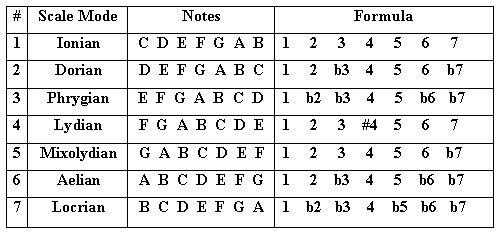
At some signal, y'all volition memorize these and find uses for all of them (except maybe Locrian). For now, just familiarize yourself with their names and sounds.
Scale degrees can besides exist written as Roman numerals like this: I ii iii Iv V7 vi viio.
When expressed this way, uppercase numerals are used for major chords, while lowercase numerals are used for modest and macerated chords (more on that later).
Intervals
An interval is a term for the space or distance between 2 notes. Each interval has a unique sound, created past its relative distance from the tonic.
Intervals come in ii types, consonant and dissonant. Consonant intervals like the "Perfect 5th" or "Major tertiary" are two notes with costless frequency patterns that resonate with each other. They're considered "stable" intervals because they don't need to resolve. Dissonant intervals similar the "Tri-tone" or "Minor second" on the other hand, are two notes whose frequency patterns disharmonism with one another, thereby creating a more than jarring, unpleasant sound. Dissonant intervals are considered "unstable", meaning they want to resolve to another, nearby consonant interval.

There are 12 basic intervals. These intervals are referenced oft when discussing scales, chords and harmonies, and are indispensable to chord edifice, which nosotros'll take a wait at next.
Chords
chords are built from scales using intervals. Standard chords comprise 3 notes.
We are using the "C" major scale for reference: C D East F Chiliad A B C
A major chord comes from placing a minor 3rd on top of a major 3rd. The altitude betwixt the lesser and top notes is a perfect fifth. A minor chord is created past lowering the 3rd by a one-half step, thus inverting the intervals so that the lesser of the chord is a pocket-size tertiary and the top is a major third.
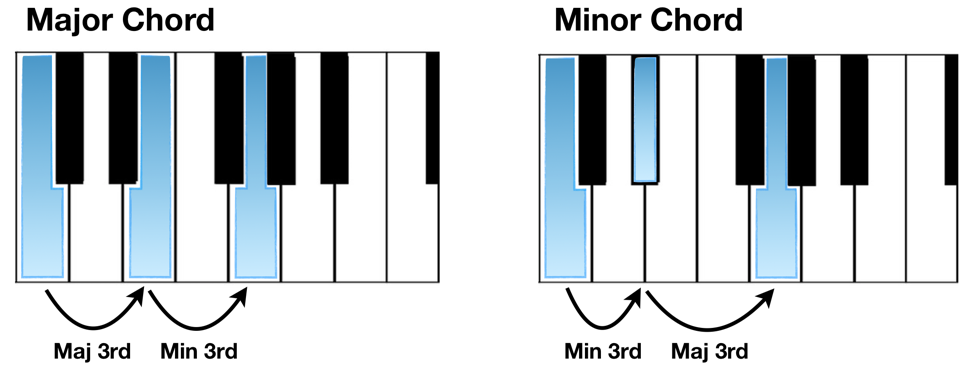
Nosotros can also express this using numerology.
A major chord uses the formula 1 3 five: C D E F G A B C
The small chord uses the same formula with the flattened/minor third.
1 ♭3 5: C D E♭ F G A B C
These aforementioned formulas tin be applied to other notes in the scale to build more chords in the key…
D minor: C D Eastward♭ F G A B C
There are two other need-to-know chord types for beginners, macerated and augmented. These chords are anomalous and need to resolve back to another, harmonious chord.
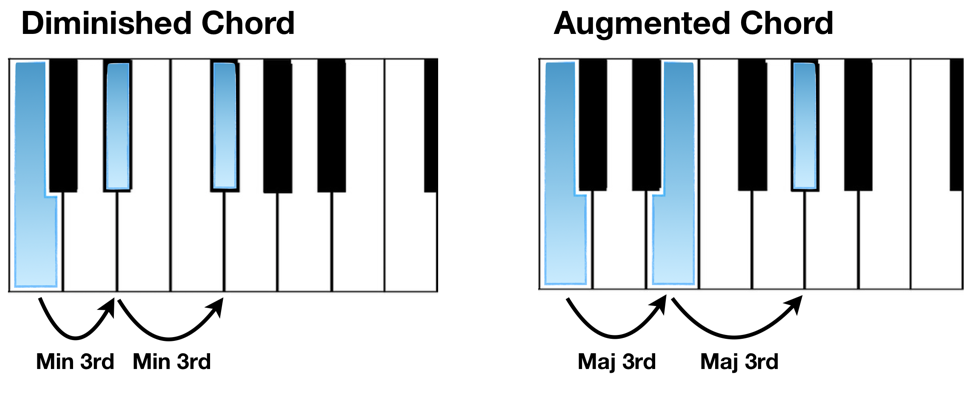
A diminished chord is fabricated up of two minor third intervals; the perfect 5th then becomes a macerated 5th.
An augmented chord is made upward of ii major 3rds; the perfect 5th then becomes an augmented 5th.
A macerated chord uses the formula 1 ♭3 ♭5: C D E♭ F G♭ A B C
An augmented chord uses the formula 1 3 #5: C D E F G# A B C
When referring to the tonal quality of chords, nosotros assume that a chord without whatever additional labeling such as minor, diminished, augmented or otherwise, is major. This means if you lot say, "the song starts on an F chord", you are past default referring to "F" major. Unless you otherwise specify that the chord is modest, augmented or diminished, it will always default to major when written and spoken.
A diminished chord is written with "o" as in "Co" for "C" macerated. An augmented chord is written with the "+" sign as in "C+" for "C" augmented.
Key Signatures
A musical fundamental is a grouping of pitches or the scale that forms the basis of a vocal'south harmonic structure. Keys are expressed as key signatures on written music annotation. This key signature tells the musician which key the limerick is in and, therefore, which notes will be sharp or flat. This eliminates the need to manually pencil in precipitous and flat notes when writing music notation. We'll talk about this a chip more in the adjacent section.
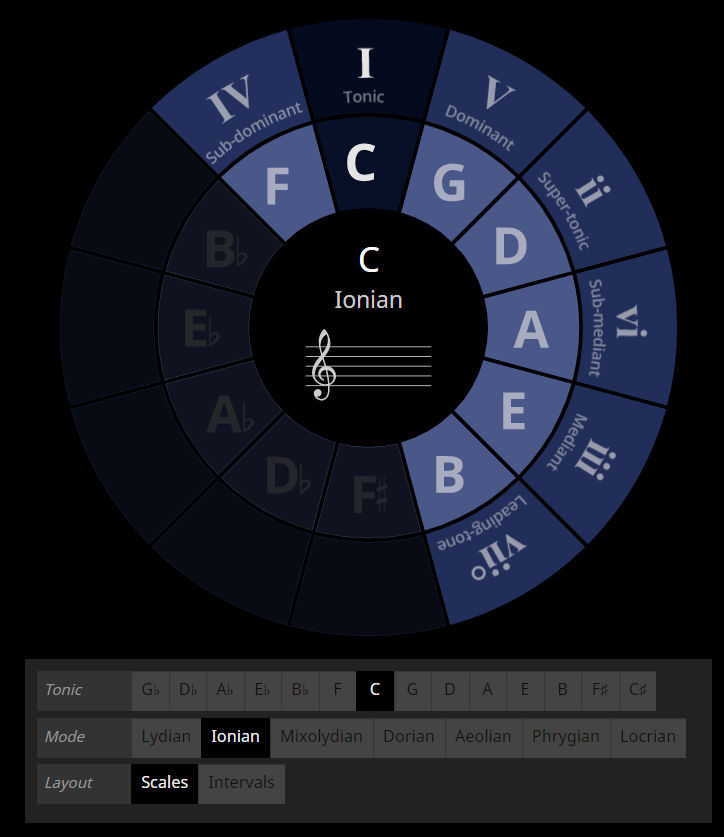
The circle of fifths (above) works to organize musical keys past placing the well-nigh closely related keys side by side to 1 another. This is a more intuitive manner of agreement music theory than putting the keys in alphabetical order. Let me elaborate...
If nosotros were to arrange the keys in sequential or chromatic society, things would go disruptive quickly.
For example, if nosotros outset with the first key of "C" (spelled C D Eastward F G A B C) and move upward half pace to the next key of "C#" nosotros would get a calibration spelled C# D# E# F# G# A# B#.
These two major scales couldn't accept whatever less in common, in fact they don't even incorporate Whatsoever of the aforementioned notes.
However, if we beginning on "C" and move up by a perfect fifth to "G" (the next key in the circle), something magical happens…
C D E F One thousand A B C becomes G A B C D E F# G.
Notice anything? We've but added one sharp, F#, (which nosotros tin find two letters dorsum within the circumvolve).
If we continue this design and go from "G" to "D" we go D E F# G A B C#. At present nosotros have two sharps, F# and C#. We can keep this pattern in perfect 5ths adding one abrupt note to each key. This pattern repeats unto itself.
When nosotros move through the circumvolve backwards or counterclockwise, we get the descending "cycle of fourths", or flat keys. Again, each sequent flat key gains i flat note. At a certain bespeak the flat and sharp keys will overlap. These are again chosen enharmonic keys, considering they sound the exact same merely tin can be labeled differently. Usually, the key that has the to the lowest degree number of accidentals is chosen out of convenience. For example, "A#" contains 4 precipitous notes and iii double sharp notes! Highly undesirable. The corresponding flat fundamental of "B♭" major even so, contains just two flat notes, making it much easier to read and write.
This comes into common practice in jazz, especially with horn and woodwind players; instruments like trumpet, saxophone, clarinet and trombone, who typically read music in apartment keys. Reed and brass instruments were the pioneering vocalization of jazz and therefore, many jazz standards are written in the flat key as opposed to the enharmonic precipitous key.
Each major key in the circumvolve too has a respective "relative" pocket-size fundamental. This is the minor scale that contains the same notes as the relative major scale. For case, the "A" minor calibration is spelled A B C D E F M A, without any sharps and flats, only like "C" major. These scales belong to the same key, and can be used interchangeably within the same key signature.
Sometimes, musicians will use notes from "outside" of the given key signature. This is especially common in jazz. In this case, accidentals for notes exterior the key will be written into the manuscript manually.
Chord Progressions
A series of chords played in a specific order is chosen a chord progression. Chord progressions can range anywhere from two chords to dozens of chords. Chord progressions are typically represented by roman numerals and created using several chords taken from 1 fundamental. Each musical key has chords equally the number of notes in information technology, one built first on each note of the calibration. Some common chord progressions are:
I - 4 - V7 ii - V7 - I I - V7 - six - Four
The "7" attached to the "5" chord in these examples denotes a "7th" or "dominate 7th" chord. This is a major chord with an added ♭vii calibration degree spelled like this:
Dominant 7th chord: ane 3 5 ♭seven
This chord comes from the Mixolydian fashion. The chord built from the 5th scale degree of the major scale is always dominant.
one three 5 ♭7: C D East♭ F G A B C
5 b7 1 3
Notation
Musical notation is the visual system with which we represent aurally perceived music. It is a tool that allows us to communicate our ideas with a unified organisation of code that other musicians can comprehend. Information technology would be impossible to express the conceptual side of music theory with just notation, but it is an effective and necessary tool nonetheless.
We've already looked at a scrap of annotation, just here are a few more must-know terms and symbols.
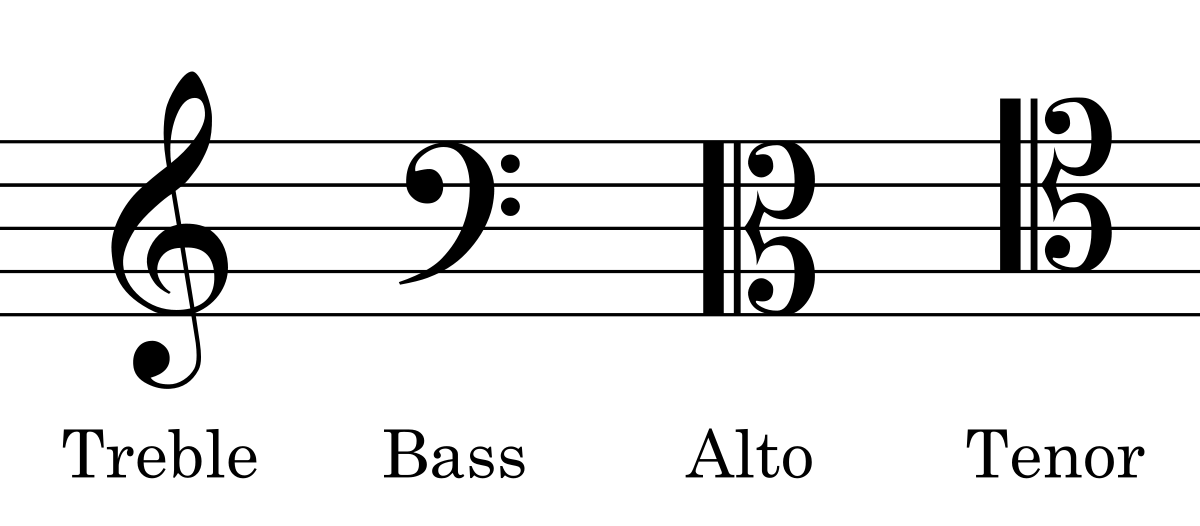
A clef indicates the pitches assigned to the lines and spaces on the music staff.
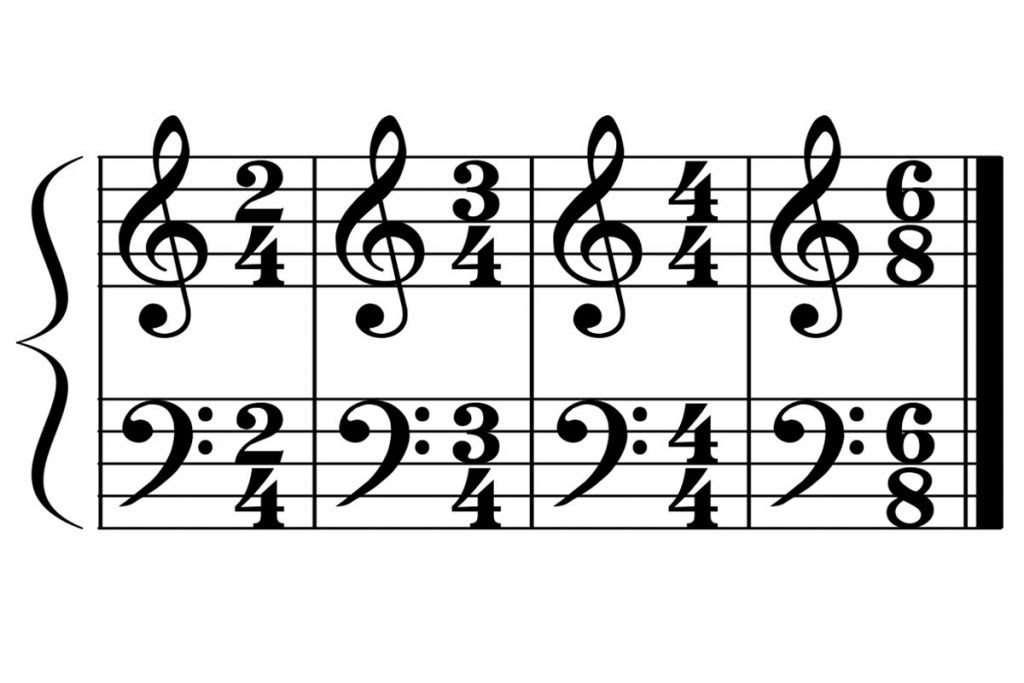
The piece's time signature, written using ii numbers stacked on top of each other, tells us how many beats are in each measure out, and which note value counts every bit one crush. The pinnacle number is the number of beats, the bottom number is the note value. iv = quarter annotation, 8 = 8th notation. Therefore: four/iv = 4 ¼ notes per measure.
Pitches are written on the staff using notes, t. The notes have "stems" which indicate how long they are played for. Each note likewise has a respective "rest", which is used to point space when the musician does not play.
A triplet is when three notes are squeezed into the space normally occupied by two notes.
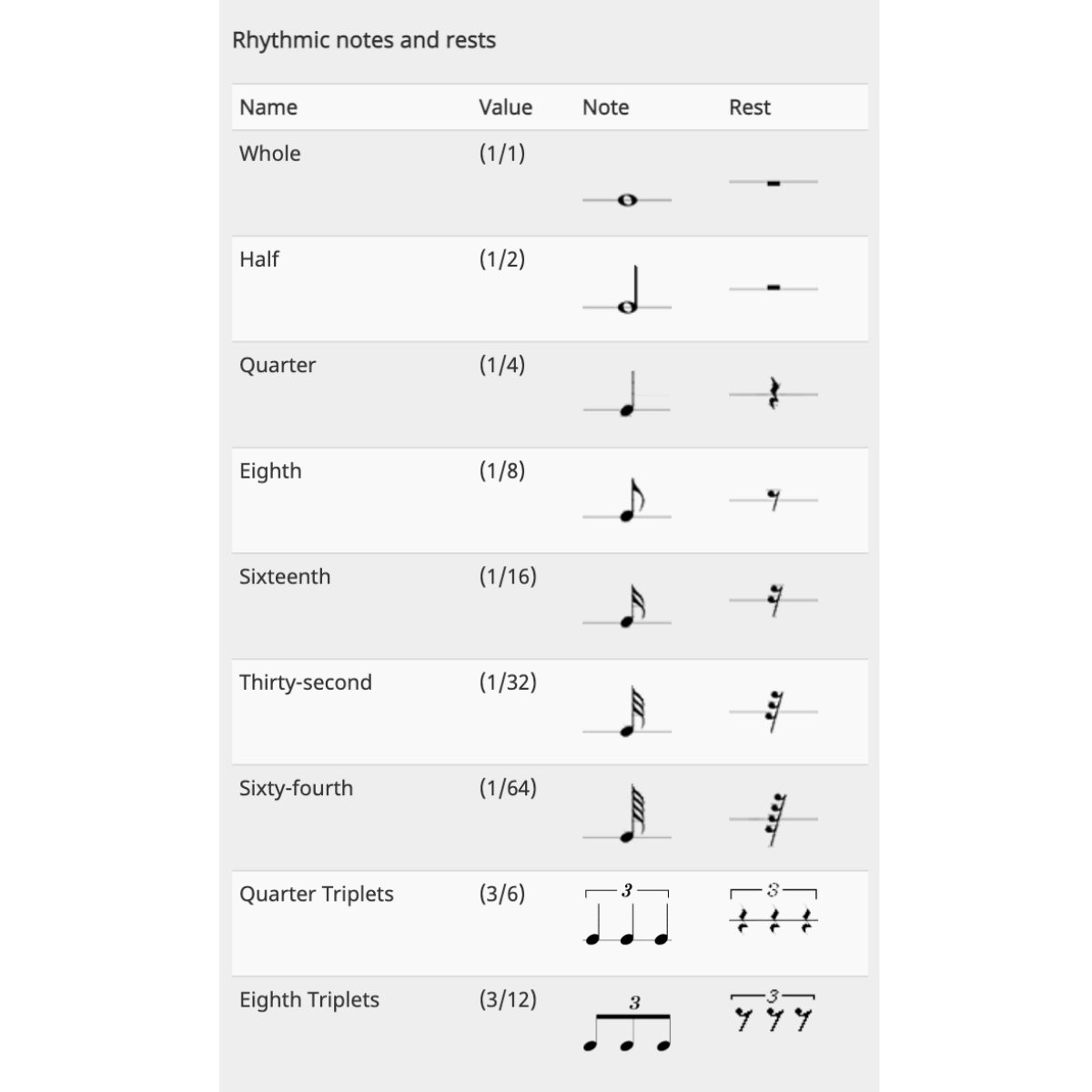
Dynamic markings (below) tell u.s. how quietly or loudly a passage or piece is to be played.
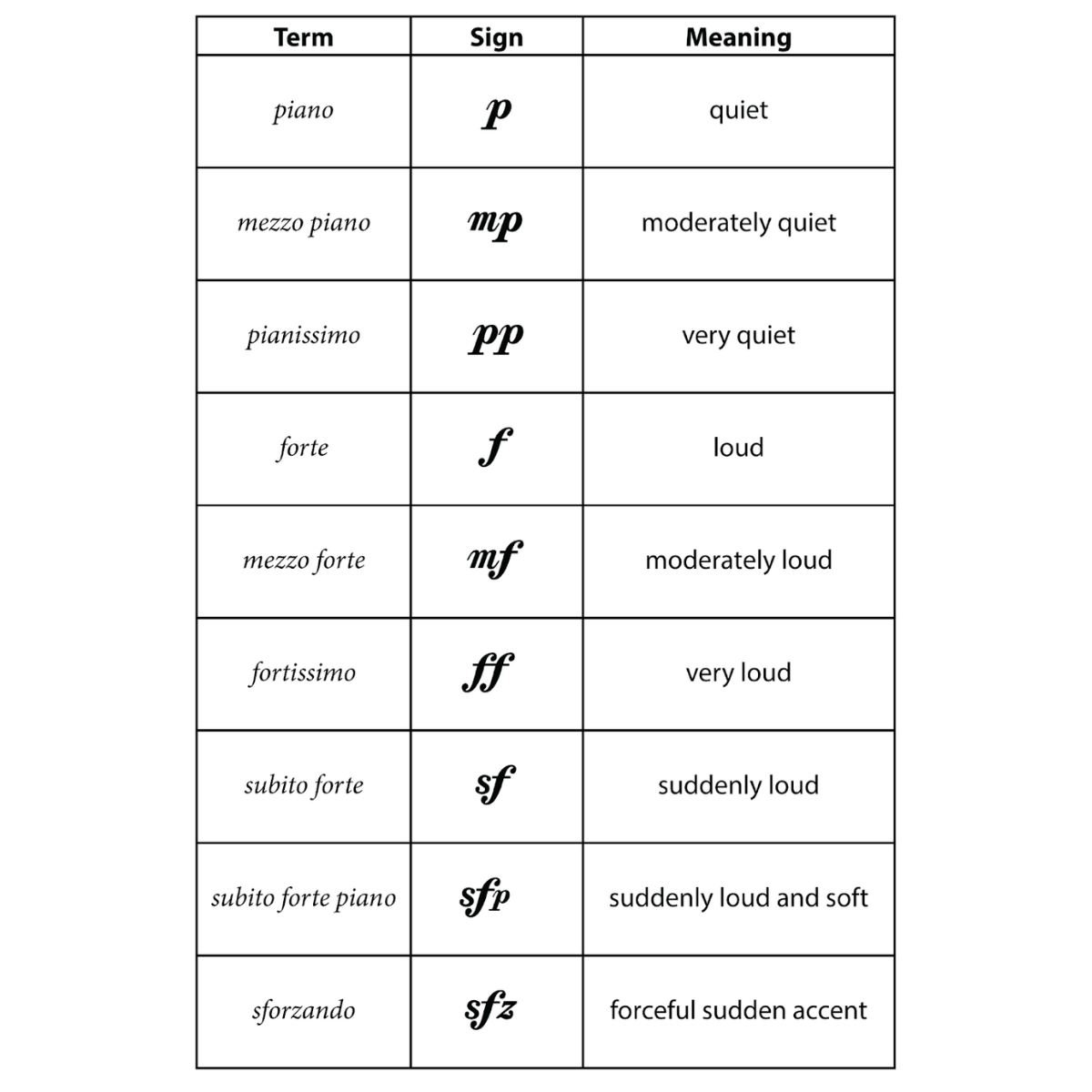
The all-time way to internalize notation and connect sound with image is to practice in ToneGym using the Notationist game!
For a comprehensive listing of music note and symbology, you tin can bank check out our index here!
Music theory exercises
Afterwards a quick brain break, don't hesitate to bound right in and put all of this into practise! The best mode to larn music is to hear it, and interact with information technology, not read nearly information technology.
ToneGym is an incredible tool for grabbing some quick, deliberate practice, and to train your ears, eyes, and brain all at the same time.
Learning music theory, like anything else, takes time and practice, then please be kind to yourself as you embark on this journey of mastering a new and complex language. Music is a joy, and learning well-nigh it is zippo but fun. Go play!
Source: https://www.tonegym.co/blog/item?id=music-theory-basics
Posted by: rolandindread.blogspot.com


0 Response to "How To Start Learning Music Theory"
Post a Comment